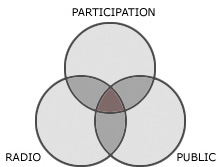Notes from VRM
Notes from the notetaker: There was so much covered and so much discussed on this day - I did not attempt to scribe the event. Alas, below are merely my own self-directed thoughts that emerged. Please add your own if you were present. -Keith Hopper
Objective:
How can the public broadcasting audience member take greater control of their relationship with public media? (â¦and as the audience becomes the former audience, how does this relationship change?)
Background Thoughts:
- Relationship does not equal transaction â in envisioning a vendor relationship tool, we need to think beyond just financial transactions (e.g. donation software)
- Incremental, internal change is not what weâre looking for here. Instead, letâs identify new ideas for experimentation on the fringes of the industry. These ideas should allow individuals to flex their creative consumer muscles in this new participatory landscape. Existing public media, broadcasters, shows, and distributors will serve as the relationships, platform, and ethos to leverage
- Letâs not attempt to address or work inside the existing public broadcasting infrastructure â a better strategy might be to 'end-run' a solution that imagines new ideas from a variety of committed individuals and asks for permission from the stations, shows, and distributors to explore these ideas. If the ideas get traction, the existing players can get involved to their level of comfort and in the ways they see valuable
- There seems to be an overlap between what's going on in participatory culture and what exists in public broadcasting. The potential exists to tap a whole new generation of creative consumers who will 'discover' public broadcasting and want to adopt it for its potential as a non-commercial, open network designed explicitly to serve the public. Can we stimulate this adoption?
- Can we reduce the friction of listener giving? Perhaps provide a capacity to donate directly to shows/programs?
- Project VRM shouldnât code software, but rather lay out ideas, standards, and support for others who can
- What's the device that will eventually replace the radio? How will this impact public radio and the relationship with the (former) listeners?
- What does the long tail of public media look like?
- Leverages democratized tools of production and redistributable media
- Leverages the cheap, fast, and widespread distribution of end-to-end environments and the benefits of aggregation
- Uses filter technology to drive demand down the tail
- If we were to reinvent public radio in an end-to-end environment like the internet, what would it look like? How would it compare to what exists, and what important differences might emerge? Can we fill those gaps?
Ideas for action:
- Make public radio the 'test project' for a vendor relationship management tool
- Provide a capacity for end-users to publish their iTunes playlists of public radio podcasts â provide a tool or environment that aggregates and features listener playlists
- Is there stuff we can do with RDS (or HD, PAD, etc.), such as publish texting codes for listeners to use in providing feedback or funding linked to specific stations, programs, and times?
- Use the existing NPR podcast directory as a platform for additional capability â specifically, experimentation with an online donation linked to podcasts
- Get a conversation or survey going with the end-users, mashup folks, or those formally known as the audience to get a better idea of needs/desires and to brainstorm ideas for creative production/control over public media
- As a creative consumer, what is it that I want to do with public media? What are my 'lego blocks'?
- Investigate a new model for a public radio station not centered on broadcast
- Embrace end-user control over programming, funding, content creation, and overall relationship
- Incorporate participatory programming direction (e.g. guest programmers, vote programs into timeslots, etc.)
- Incorporate online-only shows; act as test market for new shows
- Re-invent the traditional show model (ala Radio Open Source) to be truly conversational and participatory (What might this look like?)
- Use financial models like fundable.org to collect threshold capital to fund desired programming
- Use a small terrestrial station to carry stream and get CPB certification and permit audio use in podcasts (whatâs the secret, here?)
- Build a configurable and redistributable âuser-as-public-radio-stationâ model, integrating various streams and podcasts from around the web into a cohesive and personalized internet public radio station (e.g. KPR = Keith Public Radio)
sikis izle porno izle sex izle sikis sikis izle sikis hiphop kelebek chat kelebek sohbet chat sohbet chat porno porno izle porno siteleri sex mynet sohbet chat rap kelebek gay chat seviÅme
